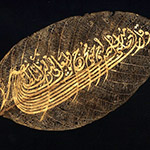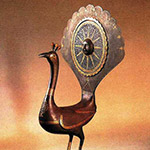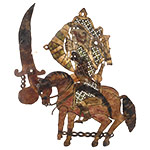Discover
Welcome, dear visitor, to this extraordinary collection of works of art, assembled with loving care.
You need not walk along corridors or into side rooms, nor stretch your neck or bend down to discover details or to read accompanying texts.
Just browse through the consecutive compartments and klick your way from one delightful specimen to the next.
We wish you a pleasant virtual promenade and would very much appreciate your comments
Artistic Handcraft
Carpets
Carpet weaving is an essential part of Islamic Art and follows a long tradition. It was transformed from a minor craft based on patterns passed down from one generation to the other into a state-wide industry with patterns created in court workshops. Each region had a characteristic style of weaving that remained the same over time. While in Persia, for instance, an asymmetrical knot was most often used, carpets manufactured in Turkey show a symmetrical one and Egyptian carpets are usually fully wool. Many carpets were traded to Europe and the Far East where they were used to cover furniture or hung on walls. Within the Islamic world, especially fine specimens were collected in royal households.
Among the oldest pieces discovered are those found in Eastern Turkestan, dating back to the third to fifth centuries AD, some of the hand-weavings of the Seljuks of Asia Minor kept in the Museum of Turkish and Islamic Art in Istanbul and the Mowlana Museum in Konya, and of course the exceptional Pazyryk carpet, discovered in the grave of a Scythian prince in Siberia.
Since Iran/ Persia has played a major role in the carpet weaving industry, we have chosen seven carpets from the Carpet Museum of Iran to be shown in this virtual museum of Islamic art. The Museum was established in 1978 with a limited number of Persian carpets and kilims and aims at reviving and developing the art of carpet weaving in the country.
The number of knots of Persian carpets is given in raj, i.e. the number of knots per row over a length of 7 centimeters (explanation as kindly forwarded by Mohsen Rahimi). And why 7 cm? This is the length of a cigarette which in turn explains why Iranians use a cigarette when taking the length of a carpet.
Ceramics
Glassware
Illustrated Stories
Jewelery
Ostarrichislam
Ostarrichislam - Fragments of 800 years of shared history
The relationship between Islam and Austria has a long and sometimes fairly controversial history, starting in 996 when Austria was first mentioned in a document as Ostarrichi. At that time a group of Pechenegs or Patzinaks, a semi-nomadic Turkic people originally from the Central Asian steppes, were living in the Hungarian plane (now the Burgenland). They adopted Islam as their religion, which, to this day, is evidenced by the name of the village of Pöttsching. Further proof can be found in the book "Tufhat al bab" of the Arabo-Islamic preacher Abu Hamid Al-Garanti († 1170), who served as imam and mufti in the Islamic community in Central Europe.
The first committed Muslims came to Austria from 1476 onwards, not as merchants, settlers, job seekers or refugees, but as soldiers of the gradually advancing Ottoman troupes, subsequently defeated in 1529 and 1683. They, of course, brought their culture and their music with them and inspired composers such as Heinrich Isaac.
In the second half of the 15th century, Heinrich Isaac wrote a piece called Allahoy, combining the music of the Mevleviye, the Whirling Dervishes, with European composing techniques. It is even possible to ascertain that the piece which inspired Isaak's composition is the oldest, surviving Ayin, or piece of ceremonial Mevleviye music. Over the years, Sufi music has inspired composers from Europe and the Americas. Maurice Ravel's Bolero, as well as Phillip Glass' Minimal Music are probably inspired by it.
Cultural and economic relations between the Ottoman Empire and Austria continued throughout the 17th, 18th and 19th centuries. In 1908 Bosnia-Herzegovina was annexed by the Austro-Hungarian Monarchy which explains the attempts undertaken to include the religion of Bosnian Muslims into the legal system. In 1912 Emperor Francis Joseph issued a decree recognizing the Hanafite school of law in order to provide religious care for the Bosnian soldiers serving in the Emperor's army.
A number of associations and societies were founded before and after World War Two until the so-called "Islamische Glaubensgemeinschaft in Österreich" (IGGiÖ) was established in 1979. The first representative mosque was inaugurated in 1977. By now, several schools and kindergartens are run in accordance with the Austrian education schedule and also offer instruction in Islam.
The influence of Islam in Austria can be seen all over the country as shown in the exhibition "Ostarrichislam". Selected objects of this exhibition are to be discovered here.


































































































